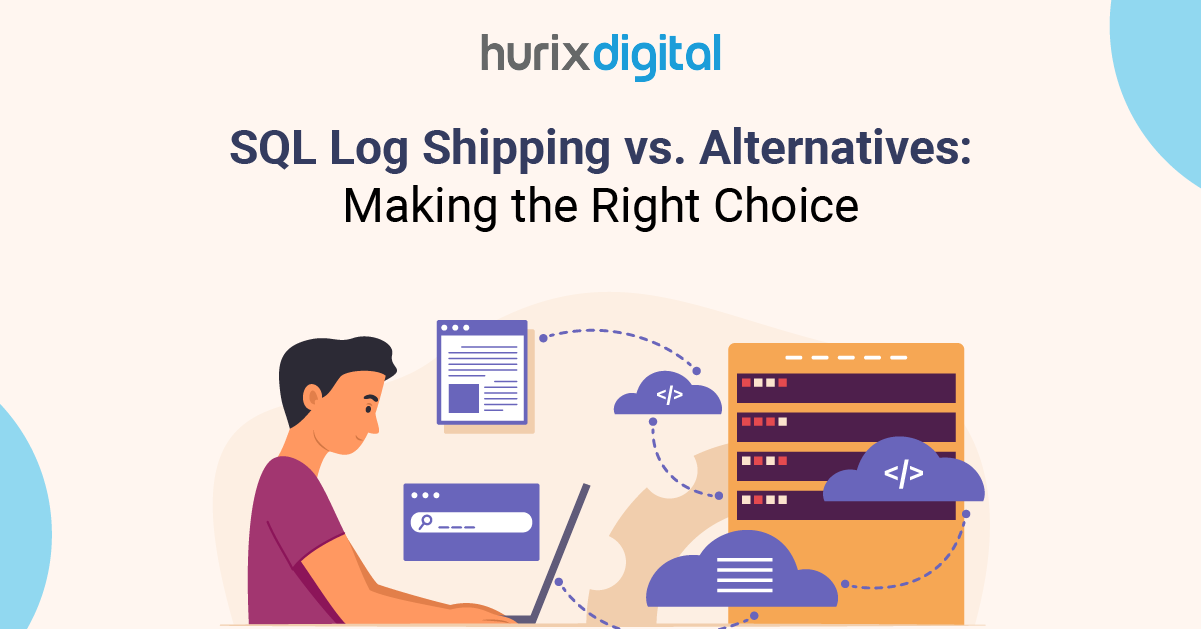
SQL Log Shipping vs. Alternatives: Making the Right Choice
Summary
This article examines SQL Server’s high availability solutions, focusing on SQL Log Shipping, its pros, cons, and cost, to aid CIOs in protecting critical databases.
As a CIO, one of your most important tasks is to ensure that your database systems are continuously available and their integrity protected. This means that you will need to identify the best way in which you can protect your organization’s critical data.
One commonly used method is SQL Log Shipping, which maintains a warm standby database to prevent data loss while minimizing downtime. Thus, this cost-effective method provides a reliable way to protect against disruptions.
However, each efficient solution comes with its own set of benefits and drawbacks. This article will explore SQL Server’s high-availability solutions, with a focus on the pros, cons, and cost analysis of SQL Log Shipping to help you make an informed choice.
Table of Contents:
- SQL Server High Availability Solutions
- SQL Log Shipping Pros and Cons
- SQL Log Shipping Cost Analysis
- Conclusion
SQL Server High Availability Solutions
High Availability means that the SQL server databases or instances will be available and reachable during a server crash or failure at minimum downtime. These can be managed effectively using SQL Server Jobs to automate routine tasks and enhance efficiency.
The different high-availability technologies provided by Microsoft SQL Server are:
1. SQL Log Shipping
SQL Log Shipping is a technique in which there are two or more SQL Server instances that are copying transaction log files from one SQL server instance to another.
This process of transferring and restoring the log files across the SQL servers is automated, thus ensuring its accuracy, efficiency, and speed.
Here, the backup of the transaction log file is taken on the primary SQL server instance, whose backup is then copied to one or more secondary SQL server instances. In certain cases, a monitor server is also maintained.
This is the optional third server instance, which records the history and status of backups and restore operations. If any of these operations do not take place when they are supposed to, then they raise an alert.
SQL Log Shipping can help maintain one or more warm standby databases for a single production database. You can also adjust the default backup time of 15 minutes to an interval that suits your business needs better.
2. Transactional Replication
In this technology, the data and database objects are copied and distributed from one database to another. These databases are then synchronized to maintain the consistency and integrity of the data.
As one of the High Availability Options for SQL, this technology can be used either continuously or can be scheduled to run at predetermined levels. Here, the primary server is known as the Publisher, and one or more secondary servers are known as Subscribers, which can be used for reporting purposes.
3. Database Mirroring
This is one of those SQL Server High Availability Solutions that can be configured on databases with a full recovery model. It consists of the primary server, known as the Principal server, the secondary server, known as the Mirror server, and the optional third server, known as the Witness server.
Database mirroring starts by restoring backups to the mirror server. Then, the mirror database is synchronized by continuously sending and applying transaction log updates from the principal database.
The Witness server will monitor the connection and availability of the other 2 servers and, if required, perform automatic failover or role change between them. Additionally, the 2 synchronization modes on which this solution works are high-safety mode and high-performance synchronization mode.
4. Always on Failover Cluster
This technology consists of a number of servers known as cluster nodes. All of these servers have the same hardware and software components to facilitate high availability for the failover cluster instance.
When this technology is configured, the SQL server services, shared storage, virtual IPs, and network will be owned by only one cluster node. However, in case of any failure on the active node or a planned reboot or update, the ownership of the above will be moved to another cluster node completely.
Thus, there would be no need for SQL Server Transaction Logs or the need to synchronize changes between different nodes. This means that there would be no replica of the database of one node on other nodes.
5. Always on Availability Groups
As one of the high-availability SQL server solutions, it consists of a primary server named Primary Replica and up to 8 secondary servers named Secondary Replicas. The primary servers will help you with read-write connections, while the secondary servers will help you with read-only connections for reporting purposes.
In this method, a problem with a specific database, like data loss or corruption, will not make the entire availability group switch to another replica, nor will it affect other databases in the same group.
Here, the data synchronization between the primary and secondary servers will depend on the SQL Server Transaction Log of that database. Additionally, while your data will be replicated in almost real-time to the warm standby server nearby, setting up and maintaining Availability Groups is complex and expensive.
You must consider all these factors before deciding between SQL Log Shipping and Availability Groups for your business.
Also Read: A CIO’s Guide to Ensuring Cloud Data Security and Compliance
SQL Log Shipping Pros and Cons
To make an informed decision between SQL Log Shipping vs. High Availability solutions, you must consider the limitations and drawbacks:
Benefits of SQL Log Shipping
- After you have planned carefully, SQL Log Shipping is very easy to set up with the help of the Database Maintenance Plan Wizard.
- Its standby databases will be able to handle read-only queries and support reporting tasks.
- If you are taking backups every hour and the transaction logs take only 10 minutes to get applied, then your downtime will be only 10 minutes. This means that your log-shipped database will be accessible for queries and reporting for 50 minutes each hour. Thus, it balances between protection and availability perfectly.
- You can also protect the security of your log-shipped databases by implementing always-on security defense strategies.
- SQL Log Shipping is a low-maintenance solution that requires very little troubleshooting. This is because even if one of the steps fails, its SQL Server will let you pick up the process from where you left it.
- It supports multiple standby servers where you can ship your transaction logs. This will help you reduce the chances of downtime. Also, you can use each server for different purposes like reporting and providing high availability.
Drawbacks of SQL Log Shipping
- If your primary server fails, then you might lose your data. This is especially applicable for those transactions that took place after the last transaction log backup to the standby servers.
- To make your standby server online, you will need to carry out some database administrator work manually.
- If you want to test your SQL Log Shipping in a production-like environment, then you will need to go through the setup wizard manually because you cannot script its setup.
- While it usually works very well, if you do encounter any issues, troubleshooting it will be difficult because the documentation is sparse and unhelpful for solving specific problems.
- Each database that you want to log-ship must be set up with its own maintenance plan.
SQL Log Shipping Cost Analysis
To use SQL Log Shipping, you will not have to invest in expensive hardware or software. Also, the capacity of your standby server does not have to be similar to that of the production server.
Additionally, the costs you incur for the standby servers will be justified because they can be used for other tasks as well.
Thus, as compared to the other High Availability Options for SQL, this method is a low-cost disaster recovery option. This is especially true because you will not require additional hardware or licensing costs like other solutions for configuring the secondary server.
Also Read: Service Level Agreements (SLAs): The Key Elements of Cloud-Managed Services
Conclusion
SQL Log Shipping is an attractive choice for many organizations because it provides a cost-effective and reliable way of maintaining a warm standby database.
While its main advantages include its simplicity and automation, its drawbacks include downtime during log application and the need for separate maintenance plans for every database.
To get a more comprehensive evaluation of SQL Log Shipping vs. High Availability Solutions, use Hurix Digital’s Cloud Advisory Services and make better decisions.
Schedule a call with us now to explore how our expert guidance will help you choose a solution that best suits your needs.

Vice President and Strategic Business Unit Head – Cloud Services
A top technology management voice on LinkedIn with 20 Years of experience in Information Technology, Cloud Services, Digital Transformation, Application Modernisation, Managed Services, IT Security Engineering and Operations Management. An avid technology Leader, Leadership Speaker, Author & Coach.








